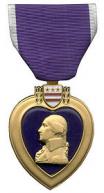I'm very glad to have found you on the web. The pin from my old unit Air Force Combat Control Pinis awesome and I'll be proud to wear it. Thank you very much.
The Purple Heart
 The Purple Heart was Instituted: 1932; The Purple Heart Medal is retroactive to 5 April 1917; however, awards for qualifying prior to that date have been made. To order your Purple Heart
The Purple Heart was Instituted: 1932; The Purple Heart Medal is retroactive to 5 April 1917; however, awards for qualifying prior to that date have been made. To order your Purple Heart
Criteria: Awarded to any member of the Armed Forces of the United States or to any civilian national of the United States who, while serving under competent authority in any capacity with one of the U.S. Armed Forces, since 5 April 1917 has been wounded, killed, or who has died or may die of wounds received from an opposing enemy force while in armed combat or as a result of an act of international terrorism or being a Prisoner of War.
Devices: Army/Air Force: Bronze, Silver Oak Leaf Cluster; Navy/ Marine Corps/Coast Guard: Gold, Silver Star
Notes: A Wound Ribbon appeared briefly in 1917, but was ultimately rescinded. (The Army used wound chevrons during World War I)
Purple Heart - Overview
The Purple Heart Medal is America’s oldest military decoration. It was originally established on August 7, 1782 by General George Washington who designed the original award called the “Badge of Military Merit.” The Badge of Military Merit was awarded for singularly meritorious action to a deserving hero of the Revolutionary War. There were only three recipients of the award, all of whom were non-commissioned officers of the Continental Army. The Badge of Military Merit was intended by Washington to be a permanent decoration, but was never used again after the three initial presentations until it was reestablished as the Purple Heart Medal on February 22, 1932 (the 200th anniversary of Washington’s birth) by the Army War Department.
During the First World War, War Department General Order No.134 of October 12, 1917 authorized a red ribbon with a narrow white center stripe to be worn on the right breast for wounds received in action. However, the order was rescinded 32 days later and the ribbon never became a reality. Instead, the Army authorized wound chevrons which were worn on the lower right sleeve of the tunic.
On July 21, 1932, General Douglas MacArthur, who was a key figure in its revival, received the first Purple Heart Medal after it was reestablished. President Franklin D. Roosevelt signed an executive order on December 3, 1942 that expanded the award to members of the Navy, Marine Corps and Coast Guard as well. Although the Purple Heart Medal was awarded for meritorious service between 1932 and 1943, the primary purpose of the award has always been to recognize those who received wounds while in the service of the United States military.
Later, Presidential Executive Orders extended eligibility for the Purple Heart Medal to military and civilian personnel who received wounds from a terrorist attack or while performing peace keeping duties. Currently, it is awarded for wounds received while serving in any capacity with one of the U.S. Armed Forces after April 5, 1917; it may be awarded to civilians as well as military personnel. The wounds may have been received while in combat against an enemy, while a member of a peacekeeping force, while a Prisoner of War, as a result of a terrorist attack or as a result of a friendly fire incident in hostile territory. The 1996 Defense Authorization Act extended eligibility for the Purple Heart to prisoners of war before April 25, 1962; previous legislation had only authorized the medal to POWs after April 25, 1962. Wounds that qualify must have required treatment by a medical officer and must be a matter of official record.
Purple Heart - Precedence
 The Purple Heart Medal was originally last in precedence of all other personal decorations, but was elevated in 1985 by an act of Congress to a position just behind the Bronze Star.
The Purple Heart Medal was originally last in precedence of all other personal decorations, but was elevated in 1985 by an act of Congress to a position just behind the Bronze Star.
The military medal is a heart-shaped, gold-rimmed medallion with a profile of George Washington on a purple enameled base. Above Washington’s profile is the shield from his family’s coat of arms. “FOR MILITARY MERIT” is inscribed on the reverse. The ribbon is a dark purple with narrow white edges. The original Badge of Military Merit was a satin purple heart edged in white. The format may have been used since the strongest wood available for gun carriages and weapons during the Revolution was called “Purpleheart”, a very strong smooth grain wood from Latin America that was stronger than the famous English oak. Here was an American wood that was stronger, more resistant to rot and termites than any other known wood. Perhaps General Washington chose the American Purpleheart wood as a symbol of strength and resistance over the British hearts of English Oak (a popular English military song of the time).
Additional awards of the Purple Heart Medal are denoted by bronze and silver oak leaf clusters or gold and silver stars, depending on the recipient’s Service Branch.

